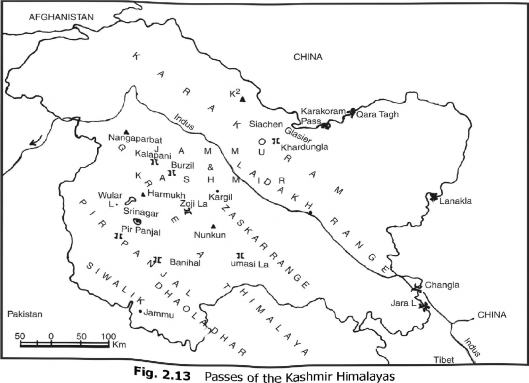1. The Kashmir Himalayas
Sprawling over an area of about 3.50,000 sq km in the state of Jammu and Kashmir, the range stretches about 700 km in length and 500 km in width. With an average height of 3000 m, it has the largest number of glaciers in India. The Ladakh region of the Kashmir Himalayas is characterised by cold desert conditions. Ladakh is one of the loftiest inhabited regions of the world (3600-4600 m). The gorge of Gilgit is 5200 m in height above the sea level of the water at its bed.
Surrounded by the Greater Himalayas and the Lesser Himalayas is the Kashmir Valley. Having a height of 1585 m above the sea-level, the total area of the Kashmir Valley is about 4920 sq km. It is a structural longitudinal ‘Dun’ (D.N. Wadia). A special feature of the the Vale of Kashmir is the Karewa (lacustrine) deposits consisting of silt, sand and clay. These karewas are mainly devoted to the cultivation of saffron and have orchards of apple, peach, almond, walnut and apricot. Kashmir Himalayas are characterised by high snow covered peaks, deep valleys, interlocked spurs and high mountain passes. Pir-Panjal, Banihal (Jawahar Tunnel), Zoji-La, Burzil, Khardungla, Pensi-La, Saser-La, Lanak-La, Jara-La, Taska-La, Chang-La, Umasi-La, and Qara-Tagh-La (Karakoram) are the important passes of the Kashmir Himalayas (Fig. 2.13).
The Himadri'. Called the abode of gods, this section of the Himalayas has many snow' capped peaks, such as Nanga-Parbat (8119 m), Nanda Devi 7817 m ), Trisul (7140 m), Nunkun (7135 m), Kamath (7756 m) etc.

